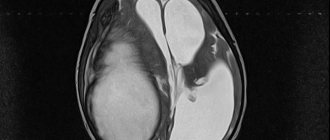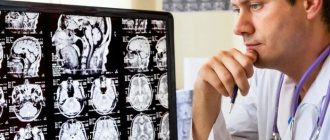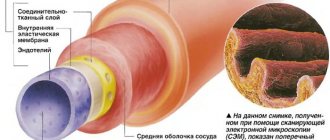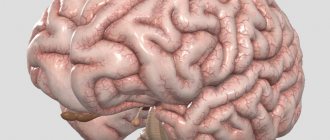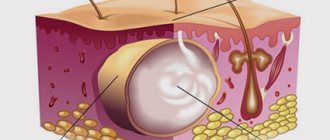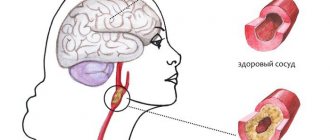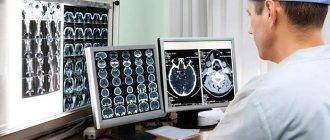An aneurysm is a pathological formation in the form of a local expansion of a blood artery in the brain due to a weak, inelastic, thinned vascular wall. The disease is serious and can lead to death. It is dangerous due to the rupture of the vessel at the site of expansion, after which subarachnoid or intracerebral hemorrhage occurs.
Aneurysm on angiography results.
Until the moment of crisis, the disease can develop asymptomatically, sometimes giving mild neurological symptoms, which are easily confused with other harmless diseases. Often a person does not assume that he has a “bomb” in his head that has been “hiding” for years, but can explode at any moment. After the vessel bursts and blood pours out of it, filling the structures of the brain, the aneurysm already manifests itself in full force. The fundamental signs of a hemorrhage are a sudden, terrible headache and loss of consciousness. Unfortunately, late provision of medical care usually ends in tragedy.
The disease can occur at any age, but is more common in young people (20-45 years old) and middle-aged people (45-60 years old). The overall incidence rate in the adult population ranges from 0.3% to 5%; in children, aneurysms are a very rare phenomenon. According to statistics, due to sudden bleeding in the brain due to aneurysms, 30%-50% of people die, 15%-30% become disabled, and only about 20% return to relatively normal working capacity. Yes, the numbers are disappointing, but with early diagnosis and timely treatment, even such a formidable lesion in the brain can be successfully neutralized.
What can affect the formation of a vascular aneurysm, what types there are, how to prevent a tragedy, it is important for absolutely everyone to know about this. So, let's move on to the main thing in detail.
Causes of cerebral aneurysm
The role of factors provoking vascular aneurysm is still being studied by scientists. Most researchers agree that the disease occurs due to the influence of several causes on the body at once. In neurology, it is customary to distinguish between congenital and acquired causes of aneurysm formation.
Congenital factors include genetic abnormalities that provoke pathological changes in the structure of connective tissue fibers, as well as the formation of arteriovenous anastomoses between arteries and veins. The most common genetic abnormalities that are combined with an aneurysm include the following:
- fibromuscular dysplasia;
- Osler-Rendu syndromes;
- Moyamoya;
- Marfana;
- Ehlers-Danlos;
- elastic pseudoxanthoma;
- systemic lupus erythematosus;
- tuberous sclerosis.
Arterial hypertension
Arterial hypertension plays a major role in the occurrence of the disease, the main manifestation of which is a persistent increase in blood pressure (BP). With a long course of this pathology and the absence of adequate drug treatment, a number of serious vascular damage occurs. An increase in pressure provokes increased hemodynamic stress on the vascular wall. If the patient has other predisposing factors, this pathological process leads to the formation of an aneurysm.
Consequences
Death is the most severe complication of a rupture of an aneurysmal sac on a vessel supplying blood to the brain or spinal cord. Mortality – in 50% of cases of dome rupture. 25% of patients who have suffered a rupture of a vessel become disabled. Possible consequences:
- Coma that lasts for a long period of time.
- Hydrocephalus, which requires surgical removal (due to blockage of the outflow tract of cerebrospinal fluid with blood particles).
- Paralysis of the limbs, body, unilateral or bilateral.
- Vasospasm leading to another stroke, this time ischemic.
- Necrosis of brain tissue, leading to loss of intellectual abilities, self-care skills, and disruption of the urinary system.
- Displacement of brain structures causes speech impairment (dysgraphia, dyslexia), complete loss of vision and hearing.
If a patient has a small cerebral aneurysm rupture, the consequences may be less disastrous. But we must not forget about the possibility of repeated rupture of the vascular wall, which will lead to disruption of blood flow.
Classification of cerebral aneurysm
In neurology, a broad classification of blood vessel aneurysms is used. First of all, they can be divided into three main types: true, false (traumatic) and stratified. True ones, in turn, are divided into sclerotic, syphilitic, mycotic and arrosive, false - into arterial, arteriovenous and combined, dissecting - into aortic and peripheral artery aneurysms.
Depending on the form of pathology, it is customary to distinguish fusiform and saccular aneurysms. The classification of aneurysms, depending on the arteries on which they are localized, distinguishes the following types of pathology: multiple aneurysms (located on several arteries at once), as well as aneurysms on the middle cerebral artery, on the arteries of the vertebrobasilar system, on the internal carotid artery, on the anterior cerebral artery .
Accurate detection of the location and size of the aneurysm is crucial in selecting optimal methods for treating the disease. The size of the aneurysm determines the likelihood of it rupturing. Depending on the size of the formations, they can be miliary (no more than 3 mm), ordinary (up to 15 mm), large (range 16-25 mm), giant (more than 25 mm).
Make an appointment with a neurologist
Clinic No. 1 in Moscow offers a consultation with a neurologist. The multidisciplinary medical center is located in close proximity to Lyublino station. Patients are offered a flexible system of discounts, examination and treatment in a modern clinic equipped to all medical standards, in comfortable conditions and with a guarantee of safety. You can make an appointment on the website or by phone.
Moscow, st. Krasnodarskaya, house. 52, bldg. 2
+7
We work on weekdays and weekends from 8.00 to 21.00
Symptoms of cerebral aneurysm
Most patients who have a vascular aneurysm do not complain of any specific symptoms until it ruptures. This reason explains the high mortality rate of patients. Sometimes an aneurysm manifests itself with mild symptoms, which the patient almost always ignores. However, a number of symptoms can be identified that indicate the presence of an aneurysm, which usually appear if its size increases. The most typical symptoms include the following:
- Visual impairment. If the aneurysm is localized near the optic nerves, this leads to partial compression of them and vision problems. The closer the formation is located to the intersection of nerves, the more serious the consequences of a cerebral aneurysm may appear (partial or complete blindness).
- Headache. Painful sensations appear due to compression of the soft and arachnoid membranes of the brain, in which many nerve fibers and pain receptors are localized. The headache is usually unilateral, subacute, throbbing, and localized in the area behind the eyes.
- Cramps. Large aneurysms, the size of which exceeds 25 mm, compress the motor parts of the cerebral cortex, which provokes seizures. By their nature, seizures differ from epileptic attacks, but differences between them can only be detected after differential diagnosis.
- Damage to cranial nerves. Compression of the cranial nerves often leads to complications such as paralysis of facial muscles, severe tinnitus, drooping of the upper eyelid, auditory hallucinations, and taste disturbances.
- Transient ischemic attack. It is a violation of cerebral circulation lasting about a day. Typical symptoms of such an attack are vomiting, nausea, loss of consciousness, dizziness, memory loss, loss of orientation in space, speech impairment, paralysis.
Clinical picture
Clinical manifestations of a cerebral aneurysm without rupture may be as follows: diffuse headache (10–20%), unilateral throbbing headache (40%), tingling sensation, numbness in the face (20%), weakness in one side of the face (10%), blurred vision (50%), pain in the eye area (30%), double vision (15%), seizures with loss of consciousness, cramps in the limbs (30–40%).
An objective examination of the patient can reveal a general cerebral syndrome, decreased visual acuity, diplopia, facial hypoesthesia, and convulsive syndrome.
Rupture of a cerebral aneurysm
The most dangerous complication of a vascular aneurysm is its rupture and subsequent subarachnoid hemorrhage, which often causes the death of the patient. Many patients notice a number of symptoms several weeks before the tumor ruptures. If you immediately seek help from a doctor after they appear, you can significantly increase your chances of recovery.
Symptoms that precede a rupture of an aneurysm are dizziness, convulsions, double vision, pain in the area behind the eyes, speech problems, tinnitus, and drooping upper eyelid. If the aneurysm ruptures, the patient experiences a sudden, severe headache. It appears due to the effect of ruptured blood on the membranes of the brain, on which many nerve endings are located.
Patients also experience symptoms of meningeal irritation caused by exposure to blood. Patients complain of photophobia, pain in the muscles of the legs and back, and the inability to touch the chest with the chin due to limited neck mobility. Frequent signs of hemorrhage are nausea and vomiting, which were not caused by food intake. Almost half of the patients experience frequent loss of consciousness, which occurs due to increased intracranial pressure. Over time, the pressure becomes so high that serious disruption of blood circulation to the brain occurs. This leads to oxygen starvation of the brain, which provokes the loss of various neurological functions.
Diagnosis of cerebral aneurysm
Diagnosis of a cerebral aneurysm should be a complex process, the main goals of which are both detection of pathology and assessment of the patient’s health, identifying other serious diseases. An important stage of diagnosis is the collection of anamnesis, which involves determining the following indicators: family history of diseases, the presence of injuries in the patient, other systemic pathologies and allergic reactions, the time of appearance of the first signs of the disease and their severity.
The neurologist then begins a physical examination, during which he applies the following procedures:
- palpation - allows you to identify symptoms of connective tissue diseases accompanying an aneurysm;
- auscultation - detects murmurs at the level of the aorta, carotid arteries and heart;
- measuring blood pressure - elevated blood pressure indicates the likelihood of aneurysm rupture;
- neurological examination - carried out to assess skin and tendon-muscular reflexes, motor activity, irritation of the meninges.
Medical imaging methods are also used to accurately diagnose vascular aneurysms:
- Computed tomography: reveals sac-like dilated vessels, destruction of bone tissue, symptoms of intracranial bleeding, and the presence of blood clots in the aneurysm.
- Angiography: necessary to track the trajectory of blood vessels and determine where they are narrowing or dilating, as well as identifying blood clots.
- Magnetic resonance imaging: used to detect protrusion of the vascular wall, symptoms of cerebral hemorrhage, and compression of nerve trunks.
- Positron emission tomography: allows you to identify areas of reduced and excessive blood circulation.
- Plain radiography of the cervical spine is used to identify symptoms of cervical spine injury in comatose patients.
- Transcranial Doppler ultrasound: reveals spasm of cerebral vessels, areas with impaired blood flow and dilated vessels.
- Electrocardiography: is a mandatory procedure when preparing a patient for surgery, as it allows to identify pathologies associated with the aneurysm.
- Lumbar puncture is necessary to identify ruptured aneurysms and subarachnoid hemorrhage.
Risk groups for the formation of congenital vascular aneurysms
At risk for the formation of congenital vascular aneurysms are children born to mothers who abuse alcohol, smokers, have had infectious diseases, or have been exposed to toxic or carcinogenic (cancer-causing) substances during pregnancy. It is often possible to trace the heredity of the formation of vascular aneurysms.
Smokers, people who abuse alcohol, people with arterial hypertension, endocrine (diabetes mellitus) and systemic diseases, as well as people exposed to radiation are at greater risk of developing vascular aneurysms.
Some studies indicate an increased risk of vascular aneurysms among people who used oral contraceptives.
Treatment of cerebral aneurysm
The only truly effective way to treat cerebral aneurysms is surgery. Conservative treatment is used exclusively at the stage of stabilizing the patient’s health status. Drug therapy will not eliminate the aneurysm, but it will reduce the risk of it rupturing. Patients are also prescribed medications to relieve symptoms of cerebral aneurysms.
To block calcium channels, which leads to vasodilation and improved blood circulation, nimodipine is prescribed. Anticonvulsant medications (fosphenytoin) can help slow the spread of damaged nerve impulses. To reduce the risk of aneurysm rupture, antihypertensive medications are indicated. Painkillers and antiemetic medications are also prescribed according to indications.
Principles of first aid
Before doctors arrive, those who are near the patient must be able to provide him with basic first aid. Instructions for urgent measures aimed at saving lives before a medical visit are clearly outlined below.
- Lay the victim on a flat surface, the head must be in an elevated position. A high head position will help improve venous blood circulation, thereby preventing the rapid accumulation of fluid in the cerebral tissues and swelling of the brain.
- Create conditions for a good flow of fresh air in the area where the clinical incident occurred. And it is extremely important to free the neck from constricting things, for example, remove a tie, a scarf, unbutton a shirt, etc. This measure will help maintain circulatory functions and slow down the process of mass death of nerve cells.
- If a sick person faints, the airway should be checked for patency. With your head thrown back, you need to press on your forehead while simultaneously extending your lower jaw, grabbing your chin from below. Having opened the patient's mouth, inspect the oral cavity (with your fingers) for the presence of foreign contents and tongue retraction. It is necessary to remove removable dentures, if any. To prevent a person from choking on vomit, return the head to a high pillow, turning it on its side.
- To prevent cerebral edema and reduce the volume of hemorrhage, it is important to apply ice compresses to the head (you can use frozen foods, ice packs, etc.).
- If possible, it is worth observing changes in blood pressure using a tonometer, as well as listening to the heartbeat and monitoring breathing. If, in the absence of doctors, a person stops breathing or his heart stops beating, immediately begin resuscitation measures (artificial respiration, chest compressions). Without them in this situation, the risk of a tragic end is enormous.
Unfortunately, even all these measures are not always effective after an aneurysm ruptures. For some, death occurs at lightning speed - in the very first minutes. But without special medical equipment and professional knowledge, it is difficult to understand what is going on in the body. Therefore, it is valuable not to lose composure and faith in the result. Continue to constantly fight for life until you personally hand over the patient to the hands of specialists.
Surgery
The main goal of surgical treatment is to isolate the aneurysm and eliminate it from the cerebral circulation. To do this, the following surgical techniques are used: craniotomy and clipping of the aneurysm, as well as endovascular removal of the aneurysm.
The first technique involves opening the patient’s skull and installing a special metal clip on the neck of the aneurysm. Thanks to this, doctors are able to achieve gradual necrosis of the aneurysm and its further replacement with connective tissue. Endovascular removal of an aneurysm involves inserting a flexible catheter into the bloodstream through a distant vessel and further advancing it into the aneurysm. At the next stage, a special coil is inserted from the catheter into the aneurysm, causing its blockage and subsequent death.
Rehabilitation of patients
If the patient suffered a rupture of an aneurysm and survived, or when he underwent surgery to remove it, he needs to undergo a rehabilitation course.
It includes three areas:
- Treatment by position using special splints. This rehabilitation method is necessary for paralyzed patients. It is carried out in the early stages.
- Massage performed by rehabilitation specialists.
- Heat treatment. In this case, applications with clay and ozokerite are used.
It is possible to supplement the rehabilitation course with physiotherapeutic procedures, which are selected individually and largely depend on the patient’s condition.
Prognosis of cerebral aneurysm
The prognosis for the patient depends largely on the location of the aneurysm and its size. If the aneurysm does not increase in size and does not cause any complications, then it may not require special treatment. The risk of death increases when an aneurysm ruptures and is about 30-50%. More than 25% of patients experience serious complications after rupture of the formation that lead to disability.
The only method of preventing sudden aneurysm rupture and hemorrhage is its surgical removal. You can also reduce the risk of this complication by using the following preventive measures: giving up alcohol and smoking, regularly monitoring blood pressure, eating a balanced diet, taking medications prescribed by your doctor, and limiting physical activity. Self-medication is strictly contraindicated for patients, as it can cause serious complications.
About the prognosis of the disease
If it is not possible to perform the operation, the prognosis will definitely be unfavorable. Although there is data about patients who lived long and prosperous lives with an aneurysm and died from other diseases. Single congenital aneurysms may disappear on their own over time, however, the risk of re-formation remains high.
The most favorable prognosis can be considered in the presence of a single formation, small in size, and also when an aneurysm is detected in a young patient. The prognosis is worsened by the presence of concomitant diseases and the presence of congenital connective tissue pathology. The overall postoperative mortality rate is 10-12%.
